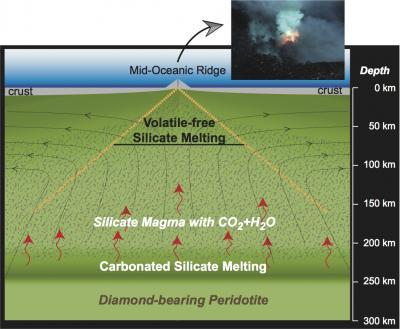HOUSTON – (Jan. 9, 2013) – Magma forms far deeper than geologists previously thought, according to new research at Rice University.
A group led by geologist Rajdeep Dasgupta put very small samples of peridotite under very large pressures in a Rice laboratory to determine that rock can and does liquify, at least in small amounts, as deep as 250 kilometers in the mantle beneath the ocean floor. He said this explains several puzzles that have bothered scientists.
Dasgupta is lead author of the paper to be published this week in Nature.
The mantle is the planet's middle layer, a buffer of rock between the crust – the top 5 miles or so – and the core. If one could compress millions of years of observation down to minutes, the mantle would look like a rolling mass of rising and falling material. This slow but constant convection brings materials from deep within the planet to the surface – and occasionally higher through volcanoes.
The Rice team focused on mantle beneath the ocean because that's where the crust is created and, Dasgupta said, "the connection between the interior and surface world is established." Silicate melts – aka magma – rise with the convective currents, cool and spread out to form the ocean crust. The starting point for melting has long been thought to be at 70 kilometers beneath the seafloor.
That has confounded geologists who suspected but could not demonstrate the existence of deeper silicate magma, said Dasgupta, an assistant professor of Earth science at Rice.
Scientists determine the mantle's density by measuring the speed of a seismic wave after an earthquake, from its origin to other points on the planet. These waves travel faster through solids than liquids, and geologists have been surprised to detect waves slowing down through what should be the mantle's express lane. "Seismologists have observed anomalies in their velocity data as deep as 200 kilometers beneath the ocean floor," Dasgupta said. "Based on our work, we show that trace amounts of magma are generated at this depth, which would potentially explain that."
The research also offers clues to the bulk electrical conductivity of the oceanic mantle, he said. "The magma at such depths has a high enough amount of dissolved carbon dioxide that its conductivity is very high," Dasgupta said. "As a consequence, we can explain the conductivity of the mantle, which we knew was very high but always struggled to explain."

A schematic cross section of the Earth's interior below oceanic ridges shows the conditions of magma generation. Through experimentation on mantle rocks, Rice University researchers found evidence that magma forms as deep as 250 kilometers inside the Earth's, much deeper than previously thought. Such melting would help explain apparent geophysical and geochemical contradictions that have puzzled geologists for years.
(Photo Credit: Dasgupta Group/Rice University)
Because humans have not yet dug deep enough to sample the mantle directly – though some are trying – researchers have to extrapolate data on rocks carried up to the surface. A previous study by Dasgupta determined that melting in the Earth's deep upper mantle is caused by the presence of carbon dioxide. The present study shows that carbon not only leads the charge to make carbonate fluid but also helps to make silicate magma at significant depths.
The researchers also found carbonated rock melts at significantly lower temperatures than non-carbonated rock. "This deep melting makes the silicate differentiation of the planet much more efficient than previously thought," Dasgupta said. "Not only that, this deep magma is the main agent to bring all the key ingredients for life – water and carbon – to the surface of the Earth."
In Dasgupta's high-pressure lab at Rice, volcanic rocks are windows to the planet's interior. The researchers crushed tiny rock samples that contain carbon dioxide to find out how deep magma forms.
"Our field of research is called experimental petrology," he said. "We have all the necessary tools to simulate very high pressures (up to nearly 750,000 pounds per square inch for these experiments) and temperatures. We can subject small amounts of rock samples to these conditions and see what happens."
They use powerful hydraulic presses to partially melt "rocks of interest" that contain tiny amounts of carbon to simulate what they believe is happening under equivalent pressures in the mantle. "When rocks come from deep in the mantle to shallower depths, they cross a certain boundary called the solidus, where rocks begin to undergo partial melting and produce magmas," Dasgupta said.
"Scientists knew the effect of a trace amount of carbon dioxide or water would be to lower this boundary, but our new estimation made it 150-180 kilometers deeper from the known depth of 70 kilometers," he said.
"What we are now saying is that with just a trace of carbon dioxide in the mantle, melting can begin as deep as around 200 kilometers. And when we incorporate the effect of trace water, the magma generation depth becomes at least 250 kilometers. This does not generate a large amount, but we show the extent of magma generation is larger than previously thought and, as a consequence, it has the capacity to affect geophysical and geochemical properties of the planet as a whole."

A microscopic sample of rock squeezed in a lab at Rice University to pressures it would experience hundreds of kilometers inside the Earth's mantle show evidence of magma (silicate melt) formation. New research led by Rice shows magma can form as deep as 250 kilometers inside the mantle.
(Photo Credit: Dasgupta Group/Rice University)
Source: Rice University